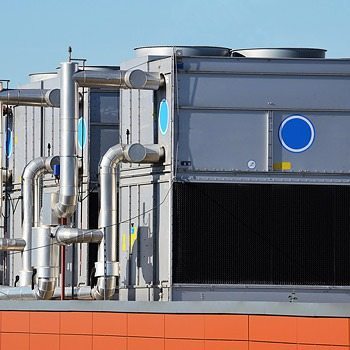 Almost all industrial operations use water in some phase of the manufacturing process. The most common process water applications are for heating and cooling operations. In fact, about 70% of all fresh water used by industry today is for non-contact cooling purposes. Chemical plants, petroleum refineries, metal producing plants, textile mills, paper mills, food, rubber, and practically all manufacturing unit processes use water for heating and cooling. Any facility that requires air-conditioning also uses water to remove heat and humidity.
Almost all industrial operations use water in some phase of the manufacturing process. The most common process water applications are for heating and cooling operations. In fact, about 70% of all fresh water used by industry today is for non-contact cooling purposes. Chemical plants, petroleum refineries, metal producing plants, textile mills, paper mills, food, rubber, and practically all manufacturing unit processes use water for heating and cooling. Any facility that requires air-conditioning also uses water to remove heat and humidity.
Non-contact cooling– The use of water
to remove heat from a unit process
without the water directly contacting the
finished product.
In performing their primary functions, power, process and refrigeration systems all develop a sizeable by-product called waste heat. This unwanted heat must be removed from these systems for their efficient operation. Waste heat is most commonly removed from these processes by water.
Waste Heat – Heat produced as a by-product
of an industrial process.
In simple terms, a heat exchanger is a unit where the waste heat from a process or piece of equipment is transferred to the cooling water, which, in turn, carries it away. Water of a suitable temperature, quantity, and quality is passed through heat exchangers, condensers, compressors, furnace jackets, and other plant equipment to absorb and carry away the waste heat. This heated water then must be either discharged into a body of water such as a lake, river, or stream; or cooled and recycled. In other words, waste heat must be removed from the primary system to a secondary system where the heat is dissipated. The secondary system is called a cooling system.
Heat Exchanger– A device to transfer
heat from a fluid flowing on one side of a
barrier to a fluid or fluids flowing on the
other.
There are three types of cooling systems; once-through cooling systems, closed cooling systems, and open recirculating cooling systems. In a once-through cooling system, water is used only once to cool the process equipment, and then is discharged to a receiving stream or river. Closed cooling systems recirculate the same water repeatedly, using secondary heat exchangers to reject waste heat from the system. In an open recirculating cooling system, water flow rejects waste heat from a process or equipment and is cooled by evaporation and sensible heat exchange through direct contact with air. This water is then continuously recycled through the system. The following sections describe these systems in greater detail.
Once-through Cooling System – A
system that uses water to cool
process equipment and then
discharges that water to a receiving
stream
Closed Cooling System – A cooling
system that recirculates the same
water over and over using secondary
heat exchangers to reject waste heat
from the system.
Open Recirculating Cooling System – A
cooling system that uses water flow to
remove waste heat from a process or
equipment. The waste heat is rejected to
the atmosphere by evaporation and
sensible heat exchange through direct
contact with air and is then recirculated
through the system.
For more information you can visit our page on cooling water treatment programs
Additionally you can visit our page on cooling water treatment chemicals
If you are looking for an easy way to buy visit out cooling water treatment shop page




